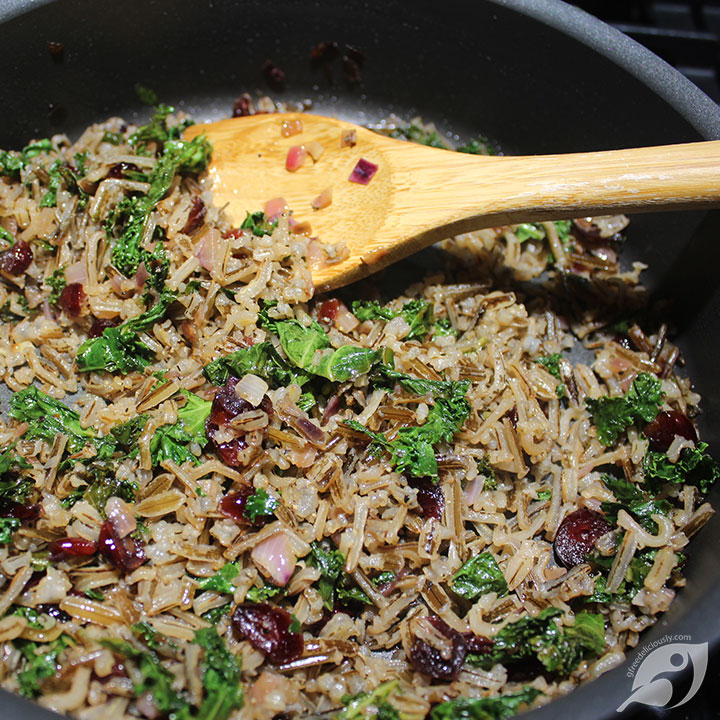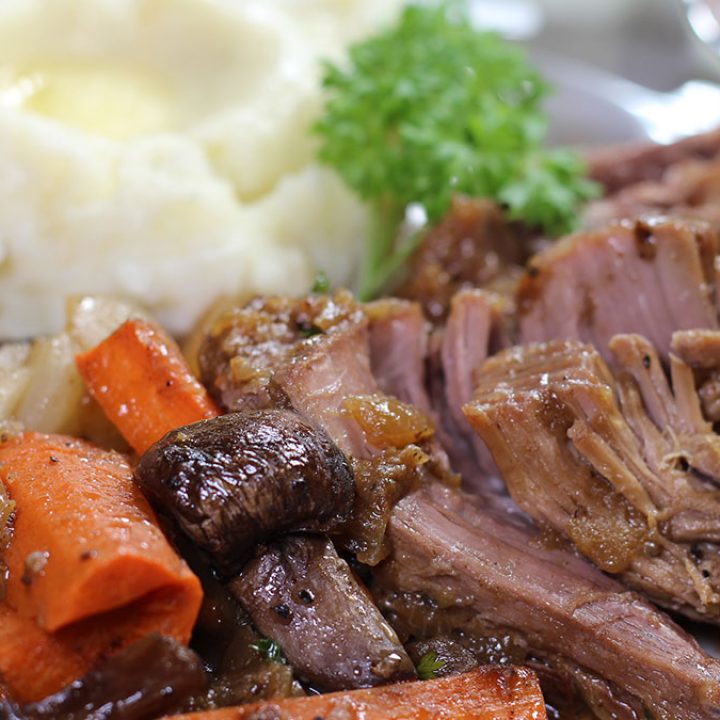Lake-Harvested Wild Rice, Cranberry, and Kale Pilaf
This ultra-simple side dish uses nutty wild rice with the sweetness of cranberries and kale to complete a dinner that doesn’t get much better!

ABOUT THIS RECIPE (per serving)
Nutrition Facts
Lake-Harvested Wild Rice, Cranberry, and Kale Pilaf
Amount Per Serving
Calories 93
Calories from Fat 23
% Daily Value*
Fat 2.6g4%Saturated Fat 0.4g3%Trans Fat 0gPolyunsaturated Fat 0.4gMonounsaturated Fat 1.7gCholesterol 0mg0%Sodium 294.2mg13%Potassium 95mg3%Carbohydrates 16.5g6%Fiber 1.5g6%Sugar 5.5g6%Protein 2.3g5%
Vitamin A 27IU1%Vitamin C 6.8mg8%Calcium 13.2mg1%Iron 0.4mg2% * Percent Daily Values are based on a 2000 calorie diet.
(Nutrition information is calculated using an ingredient database and should be considered an estimate.)

The lake wild rice (Zizania palustris) grows naturally on the lakes and riverbeds in Minnesota on more acres than any other state in the country. In Northern Minnesota, it’s hand-harvested from canoes by the Ojibwe people in reservation waters. As you might guess, the wild rice grown there has been an important social and cultural component for the Native American tribes and rural Minnesota communities.
Considered a gift from the Creator, lake wild rice grain has been a center of the Ojibwe diet and culture for centuries. According to legend, the Ojibwe followed a prophecy to find the place where the food grows on the water, which was around Lake Superior, particularly in Minnesota.
Reaped from the northern aquatic grass that bears a resemblance to the grain, the lake rice was “tamed” during the 1960s when scientists and businessmen made it into an industry. As the story goes, these men began growing the rice in paddies and planting and harvesting it by machine. During the cultivation process of the paddy grown “wild rice,” they changed the rice by making it uniform in size and almost black in appearance.
The two look and taste completely different!
I was first introduced to Minnesota lake-harvested wild rice early on in my marriage when my brother-in-law, who was then living in Minnesota, gifted me a small bag of the edible grown grain.
Kymberley | G-Free Deliciously Tweet

Signup for eNEWS UPDATES + Your FREE Basic Member Pass
♥ RECIPES + RESOURCES STRAIGHT TO YOUR INBOX ♥
Simple and delicious gluten-free recipes, family-friendly meal ideas, healthy cooking, encouragement, and easy-to-implement lifestyle strategies to live fully nourished… Only from GfreeDeliciously!
I promise not to spam you. Pinkie swear!
My preference in wild rice...
After cooking with both types of wild rice, my preference is for the nutty, earthy grain of the natural lake hand-harvested and smoke parched wild rice. It’s an instant treat to include in your cooking. You’ll notice that the grain of the lake wild rice looks irregular and is light brown. The rice has a delicious natural nutty aroma even before it’s cooked, and the taste delivers a deliciously rich, nutty flavor and enjoyable texture. It cooks up quickly, usually in just 15 to 20 minutes, making it an easy addition for just about any meal.
In comparison, you’ll find that the mass-produced paddy rice is much darker than natural-grown lake wild rice. It takes considerably longer to cook, and I’ve found that the rice is not as fluffy after cooking. Many consumers describe the taste as rather bland. I would agree. Cooking times vary depending on the heat it is cooked at, the moisture content of the rice, how it was parched, and your personal preference in chewiness. Another difference is that in most industry operations, herbicides are commonly used in spraying rice paddies. On a positive note, if you’re on a tight budget, the paddy grown variety is a little easier on your pocketbook.
My wild rice education...continue reading...
Most of my wild rice knowledge (about both grown types) was learned years after my first introduction to the grain during a sales trip to northern Minnesota.
Being my first sales ride-along to the northern part of the state, I didn’t realize the distance between the small towns and businesses on our list of daily stops. Despite the miles, the morning went by quickly. Primarily small talk about how to use the garnishes (the products I sold) in drinks and how to up-sell the distributor’s customers so we all could make money. Our day’s agenda was pretty much by the book – C-stores in the morning, liquor stores, bar-cafés, and restaurants in the afternoon.
It was a little past the lunch hour when John, my distribution manager, suggested we stop to grab a bite. We barely made it through the front door of the log cabin style bar-café when I spied a bag of wild rice on the counter that looked just like the kind I had been introduced to years before by my brother-in-law. Of course, I had to buy it. Little did I suspect my purchase would spark a whole afternoon of wild rice conversation?
Through lunch and between our afternoon stops, I became the student, learning much about Minnesota lake wild rice versus the Minnesota-grown mass-cultivated variety. The story and history of both are fascinating. I learned about the legend and spirituality of wild rice for the Ojibwe people, the labor-intensive hulling and sorting of the natural grain (called winnowing), and about wood parching to dry the lake rice, leaving it moist, fast cooking, and deliciously flavorful.
How wild rice is cultivated…
I also learned much about how “cultivated” is considered a swear word on the reservation. How, as in other types of farming and harvesting, inclement weather can affect the crops. We talked about the wild lake rice being a source of income for the people on the reservation surrounding communities and how the cheaper paddy rice has dropped the price.
After that trip, I came away with a much greater appreciation for the hand-harvested lake wild rice that had been introduced to me years before. And, in years since, my learnings about it have given me a greater appreciation for other types of food. It taught me to continually question how foods I prepare for my family are grown, how they’re harvested, and the production methods the foods go through before we eat them.
An excellent side dish...

What to pair with wild rice...
Cranberries and kale are two of my favorite ingredients to pair with lake wild rice.
In this recipe, I’m using them to make an ultra-simple side that’s an excellent complement to just about any protein dish. From fish, chicken, pork, or beef, I’ve found it a healthy and delicious blend of ingredients popular at our table by young and old alike.
But, before I get to the recipe, let me say that for years, I overlooked kale as a vegetable to include in my family’s diet. For some odd reason, I had always considered it a strong-flavored vegetable without many possibilities. But Boy, Oh Boy, was I wrong!
CLICK HERE to read about how to eat the most deliciously flavorful kale.
EQUIPMENT
- Small saucepan
- Deep Skillet
- spatula
INGREDIENTS
- ½ cup Wild Rice Minnesota lake-harvested if you can find it.
- 1-1/2 cups Water for cooking rice
- ½ teaspoon salt
- 1 tablespoon Olive Oil
- ¼ cup Red Onion
- ¼ cup Dried Cranberries Rehydrate with 3 tablespoons Apple Juice
- 2 cups Kale chopped
- Salt and Pepper to taste
- Pecans Optional - Candied Pecans for garnishing. [1]
INSTRUCTIONS
- Bring the wild rice, water, and salt to a boil in a small saucepan. Reduce heat and cover to maintain a steady simmer. Cook until the rice is tender and the grain kernels pop open, approximately 15 to 20 minutes for lake-harvested wild rice. *
- Soften and rehydrate the cranberries in apple juice until ready to use.
- Heat a deep skillet over medium-high heat, add the olive oil and the onions, and sauté for 3 to 5 minutes until softened and the onions turn translucent.
- Add the cranberries and the kale; sauté for about 5 minutes more.
- Add the cooked and rinsed wild rice. Stir into the cranberry, onion, and kale mixture. Salt and pepper to taste; sauté 5 to 6 minutes more.
- Adjust the seasoning if necessary. Serve warm.
KITCHEN NOTES
* 1 cup of uncooked wild rice will yield approximately 3 to 4 cups of cooked rice. The recommended rice-to-water ratio is about 2 to 1, or I’ve found that instead of measuring, I’ll cover the rice with about 1 inch of water before beginning to simmer. To shorten the cooking time, you can cover the rice with a generous amount of water and soak it overnight. After the rice has cooked to the desired doneness, rinse and cool completely before adding it to the recipe. [1] Make quick candied pecans on the stovetop.
Nutrition
Recipe Card powered by WP Recipe Maker
(Nutritional values are an approximation. Actual nutritional values may vary due to preparation techniques, variations related to suppliers, regional and seasonal differences, or rounding.)
Copyright © 2017-2023 Kymberley Pekrul | GfreeDeliciously | gfreedeliciously.com | All content and photographs are copyright protected. The sharing of this recipe is both encouraged and appreciated. However, copying and/or pasting full recipes to any social media is strictly prohibited. Please read my Photo Use Policy for detailed guidelines and further clarification.




























